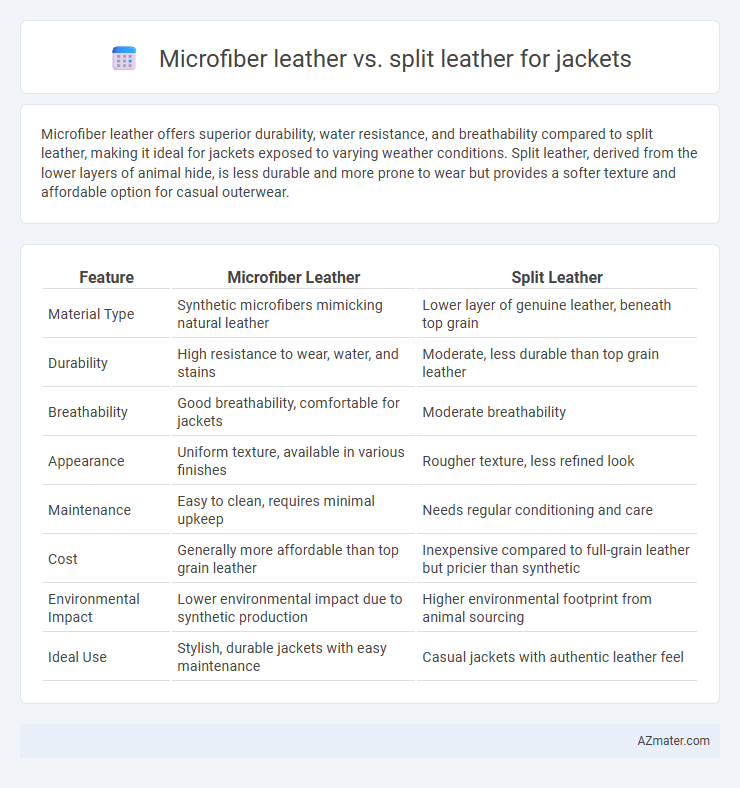Microfiber leather offers superior durability, water resistance, and breathability compared to split leather, making it ideal for jackets exposed to varying weather conditions. Split leather, derived from the lower layers of animal hide, is less durable and more prone to wear but provides a softer texture and affordable option for casual outerwear.
Table of Comparison
| Feature | Microfiber Leather | Split Leather |
|---|---|---|
| Material Type | Synthetic microfibers mimicking natural leather | Lower layer of genuine leather, beneath top grain |
| Durability | High resistance to wear, water, and stains | Moderate, less durable than top grain leather |
| Breathability | Good breathability, comfortable for jackets | Moderate breathability |
| Appearance | Uniform texture, available in various finishes | Rougher texture, less refined look |
| Maintenance | Easy to clean, requires minimal upkeep | Needs regular conditioning and care |
| Cost | Generally more affordable than top grain leather | Inexpensive compared to full-grain leather but pricier than synthetic |
| Environmental Impact | Lower environmental impact due to synthetic production | Higher environmental footprint from animal sourcing |
| Ideal Use | Stylish, durable jackets with easy maintenance | Casual jackets with authentic leather feel |
Introduction to Microfiber Leather and Split Leather
Microfiber leather, a synthetic alternative made from ultra-fine fibers bonded closely together, offers superior durability and water resistance compared to natural leather. Split leather, derived from the lower layers of a hide, is less durable and more porous, often requiring additional treatments for strength and finish. The choice between microfiber leather and split leather impacts jacket longevity, maintenance, and overall wearability.
Composition and Manufacturing Processes
Microfiber leather is composed of fine synthetic fibers, primarily polyurethane and polyester, which are intricately woven and coated to replicate the texture and durability of genuine leather through advanced manufacturing techniques such as needle punching and embossing. Split leather, derived from the fibrous inner layer of animal hide, undergoes a splitting process to separate the top grain before being treated, dyed, and embossed to enhance its appearance and softness. The manufacturing of microfiber leather involves controlled chemical and mechanical processes to ensure uniformity and water resistance, whereas split leather relies on natural hide properties and careful tanning methods, resulting in distinct differences in texture, breathability, and longevity for jacket materials.
Texture and Appearance Comparison
Microfiber leather features a smooth, consistent texture that mimics genuine leather's fine grain, offering a sleek and uniform appearance ideal for stylish jackets. Split leather, derived from the lower layers of animal hide, exhibits a rougher texture with visible imperfections and a more natural, rustic look. The glossy finish of microfiber leather contrasts with the matte, fibrous surface of split leather, affecting both the tactile feel and overall aesthetic appeal of the jacket.
Durability and Longevity
Microfiber leather offers superior durability and water resistance compared to split leather, making it an excellent choice for long-lasting jackets. Split leather, derived from the lower layers of animal hide, tends to be less resistant to wear and often requires additional treatments to enhance its durability. Jackets crafted from microfiber leather maintain their appearance and structural integrity over time, especially in varying weather conditions, ensuring prolonged use and longevity.
Comfort and Breathability
Microfiber leather offers superior breathability and comfort compared to split leather due to its finer synthetic fibers that allow better air circulation and moisture-wicking properties. Split leather, being derived from the lower layers of animal hide, tends to be thicker and less breathable, often causing discomfort and heat buildup during prolonged wear. Microfiber leather's lightweight and flexible structure enhances comfort, making it a preferred choice for jackets designed for extended use.
Water and Stain Resistance
Microfiber leather offers superior water and stain resistance compared to split leather due to its tightly woven synthetic fibers and protective coatings, making it ideal for jackets exposed to harsh weather. Split leather, derived from the lower layers of animal hides, is more porous and prone to absorbing moisture and stains, requiring additional treatments for protection. For durable, low-maintenance outerwear, microfiber leather provides enhanced performance in repelling water and resisting stains.
Maintenance and Care Requirements
Microfiber leather requires less maintenance than split leather due to its synthetic composition, which resists stains and water damage more effectively. Split leather demands regular conditioning and protection from moisture to prevent cracking and deterioration. Cleaning microfiber leather typically involves mild soap and water, whereas split leather needs specialized leather cleaners and conditioners to maintain flexibility and appearance.
Environmental Impact and Sustainability
Microfiber leather, made from synthetic fibers like polyurethane, offers a more sustainable alternative to split leather due to its lower water consumption and reduced reliance on animal agriculture, which significantly lowers carbon emissions. Split leather, derived from the fibrous layers beneath the animal hide, involves intensive tanning processes that produce hazardous chemical waste and higher ecological footprints. Choosing microfiber leather for jackets promotes environmental conservation through its durability and recyclability, aligning better with eco-friendly fashion practices.
Cost and Value for Money
Microfiber leather jackets typically cost less than split leather jackets while offering enhanced durability and water resistance, making them a cost-effective choice for budget-conscious buyers. Split leather, derived from the lower layers of cowhide, tends to be more affordable than top-grain leather but can lack the premium feel and longevity of microfiber leather. Considering long-term value, microfiber leather jackets provide better wear resistance and easier maintenance, delivering superior value for money compared to split leather options.
Final Verdict: Which Leather is Best for Jackets?
Microfiber leather offers superior durability, water resistance, and ease of maintenance compared to split leather, making it ideal for jackets exposed to various weather conditions. Split leather, while more affordable and breathable, lacks the strength and longevity of microfiber leather due to its lower grade and porous surface. For jackets prioritizing longevity, weatherproofing, and a sleek appearance, microfiber leather is the best choice.

Infographic: Microfiber leather vs Split leather for Jacket
 azmater.com
azmater.com